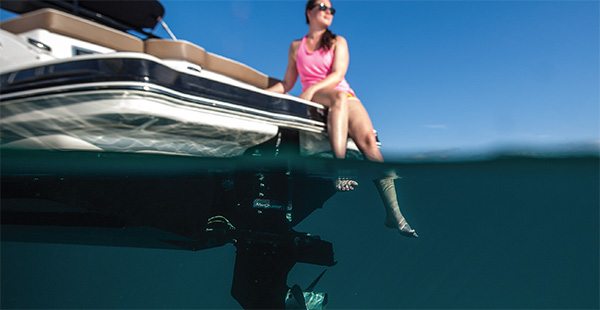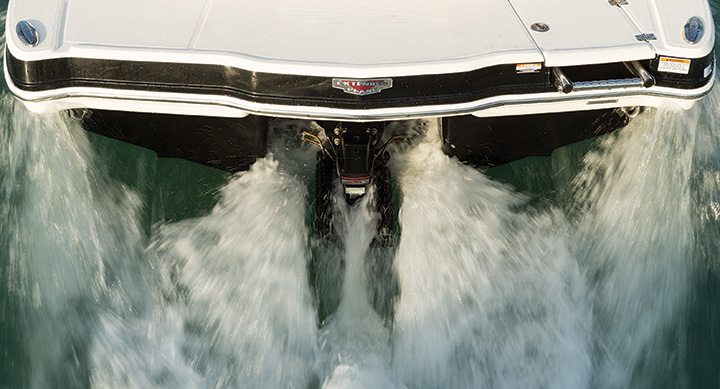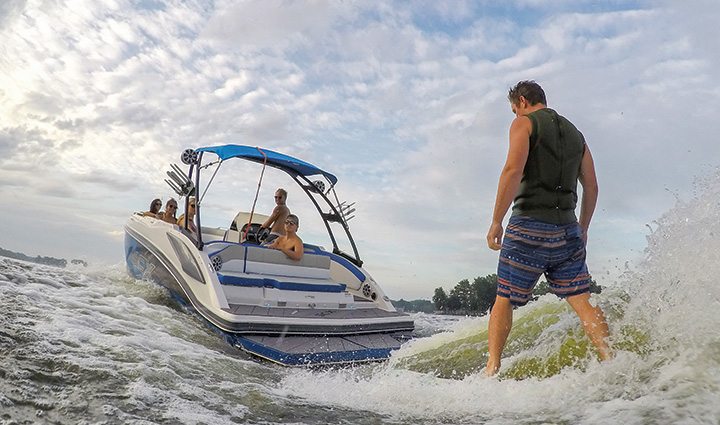Sterndrives shift to second chapter

Manufacturers embrace move to premium market segments
One doesn’t have to spend too much time at boat shows to realize that there are major changes taking place within the sterndrive engine market.
Sterndrives once dominated the cottage runabout category. It’s not too hard to recall the days when almost every boat brand offered at least a handful of models pushed by three-liter power.
Outboard engines now enjoy a complete monopoly on the under-200 horsepower market. And where sterndrives were once the defacto power source for cruisers up to 40 feet, today’s latest designs are also increasingly powered by outboards. While sales of outboard engines surge, sterndrive sales have not shown any sort of comparable post-downturn rebound, forcing manufacturers to rapidly change their market approaches.
Indeed, current data from Grand Rapids, Michigan-based Statistical Surveys Inc. show annual sales of sterndrive-powered boats to be dropping at a rate that almost perfectly mirrors corresponding sales growth in outboard-powered boats. Over the past five years, sales of sterndrive-powered boats have declined steadily from 16,666 units in 2012 to 15,060 in 2013, 13,923 units in 2014, 12,941 units in 2015 and 12,472 units in 2016 – an overall slide of 25.2 percent. Over the same period, annual sales of outboard-powered boats of all types rose from 127,981 units in 2012 to 136,488 units in 2013, 146,818 units in 2014, 157,052 units in 2015 and 165,435 units in 2016 for a net gain of 22.7 percent.

Data from the National Marine Manufacturers Association tells a similar story. NMMA’s New Powerboat Registration Data shows five years of consistent retail sales declines in the mid- to high single-digit range for sterndrives, against five consecutive years of mid- to- high single digit sales growth for outboards.
It’s an even gloomier picture when viewed in whole numbers. In terms of wholesale shipments, NMMA notes that of the 145,179 powerboats shipped between January and June 2016, just 5,616 were powered by sterndrives, giving the platform a relative market share of approximately 4 percent.
Outboard engine manufacturers cite many reasons for this shift away from sterndrive power, noting that comparable outboard-powered boats offer more cockpit space and easier maintenance. But is there more to it than that?
Seismic shifts in the boating landscape
The numbers don’t lie, but neither do they tell a complete story.
While it’s become common for many in the marine industry to compare’s today’s sales performance with various “pre-downturn” benchmarks, it is important to understand that today’s market has changed significantly from the boating market of 10 or 12 years ago – to the point that pre/post downturn sales comparisons may no longer be valid.

“Market demand today is completely different than it was pre-global financial crisis,” said Mercury Marine President John Pfeifer. “Over the past decade consumer preferences have changed substantially. Buyers are now choosing different styles of boats than they used to, with an obvious impact on the corresponding engines. Today, they’re buying pontoons rather than runabouts. The runabouts always took a 3.0-liter or a 4.3-liter sterndrive engine, where pontoons generally take outboards. So it isn’t a case where consumers have said we don’t want sterndrives any more, they’ve shifted their attention to different styles of boats, which, as it happens, are not typically powered by sterndrive engines.”
In saltwater, there is a similar shift away from the traditional smaller cruisers and toward center consoles, with a corresponding shift again away from sterndrives and toward outboards, Pfeifer added. “So the sterndrive market is not seeing growth in the marketplace, but it’s still an important part of the market, and it will be an important part of the market in the future,” he said. “That’s why we made the investment to launch our own purpose-built sterndrives instead of continuing to rely on marinized auto engines. In certain segments of the market, which typically today are say, 25 feet and above, a lot of people simply want a sterndrive product. They like the full open swim platform, and they like other features that the sterndrive gives them. So, it’s always going to be there. It’s just a question of how big it’s going to be.”
Market shifts toward specific styles of boats that tend to use outboard power have been driven in part by consumer demand – preference for the seating capacity, flat floors and high performance of modern pontoon boats among the boomers being an example – and in part by the boating industry itself. As the country emerged from the economic downturn into a fragile marketplace, boat builders were forced to operate with a greater eye on retail pricing and their own liquidity, triggering a shift away from sterndrives.
“The upfront cost to build a sterndrive-powered boat is greater than the upfront cost to build an outboard-powered powerboat,” said Ilmor Engineering President Paul Ray. “And so when you have economic challenges in the system, you have an undeniable trend towards boats that are easier and more cost-effective to build.”

But as the economy rebounds and consumer confidence grows, he said, buyers become more comfortable spending more money on their toys and their pleasure.
“Today, I think we’re going to see people looking for boats that are a little more refined, and perhaps we’ll start to see a corresponding uptick in sterndrive sales,” said Ray. “We’re starting to see sterndrive sales improve in the higher power segment that we focus on, because that’s generally a more affluent buyer. The market now seems to be switching more towards higher horsepower, more of a premium product, and less of a ‘this is the quickest way to get it out the door and onto the water’ type of thing.”
This shift away from powering mass production, low-cost runabouts to focus on larger, more refined luxury products is a big reason why sterndrive sales figures have not returned to previous levels. It also suggests they won’t do so at any point in the future. But leveraging the product’s inherent strengths could secure its future by allowing sterndrive to dominate high margin, niche markets.
Premium positioning
“What is really starting to happen in the sterndrive industry is that you’re seeing a considerable investment in improved technologies, like the joystick systems and improved control systems that provide a more refined experience when you go boating,” said Ray. “Sterndrives capitalize on the phenomenal technology that’s being built into cars and trucks, and leverage the billions of dollars that are invested in improving fuel economy and performance. It’s no longer necessary to have a big block Chevrolet engine in the back of your boat to get plenty of horsepower. You can do that with a small, lightweight aluminum engine that produces incredible fuel economy, but with the same power and longevity as the old giant 8.1-liter engines.”
The high-tech found in the current Gen5 GM powerplants also represents a point of differentiation for Volvo Penta, setting the product apart from sterndrives of the past.
“We are selling a lot of sterndrives in the premium end of the market,” said Jens Bering, vice president of marine sales for Volvo Penta of the Americas. “We are now reaching a new level with performance and fuel economy, and in particular, with emissions. I don’t think we speak enough about the low emissions of our new Gen5 engines. They are so clean, and so far beyond the bar that’s been set for us by the EPA. We spend a lot of money in [research and development] and the tremendous performance of the new product reflects that investment.”

The path ahead
“Sterndrive has become a niche product,” sais Phillip Secord, North American sales manager at Yanmar Recreational Marine of the Americas. “Moving forward, sterndrive is not going to be a powerhouse. It will appeal to a specific buyer who has to have a specific need. Diesel units offer incredible efficiency and power. If someone could come up with a 500-plus horsepower diesel sterndrive, I think you’d create a whole new market, and the volume on that could be fairly significant. The trick is handling that amount of torque. We have a very robust sterndrive now, and there is talk about a larger one coming. That has real potential.”
Volvo Penta also sees potential in diesel sterndrives, for both its recreational and commercial customers. “In Europe, we sell a tremendous number of diesel sterndrives,” said Bering. “There are regions in the United States where people are more prone to buy a diesel than they are to buy a gas sterndrive or an outboard. Interest in diesel right now is at a steady level.”
While diesel may hold some future promise for Volvo, by far the greatest opportunity for the company lies in its Forward Drive system. Widely adopted by manufacturers of surfing runabouts, Forward Drive units now account for close to 20 percent of Volvo Penta’s North American sterndrive revenues.
“Our sterndrive unit sales are growing every single month right now, and certainly a big portion of that is due to the Forward Drive,” said Bering. “I think people are really starting to embrace the versatility that it represents. Instead of just buying a single-purpose surfing boat, a family can now buy a more versatile boat that can let them do a little bit of everything, including wakesurf.”

Bering is careful to attribute a good deal of credit for the success of the Forward Drive system to dealers who actively embrace opportunities to introduce the product to their customers and show them how easy wakesurfing is.
“The more successful dealers are very proactive about showing their communities and getting them out to do this water sport,” said Bering. “They actively engage them, and get them off the couch, to try this fun, family activity. The Forward Drive opens new opportunities, but it is the dealers who really take the time to educate their community that are the most successful. It’s not showing people the Forward Drive, it’s showing people how they can have so much fun in their boat.”
For its part, Mercury has also responded to the growth of the wake surfing market, albeit with a different approach. “That’s why we developed our JPI product and introduced it in Miami,” said Pfeifer. The JPI is an inboard product that gives you a joystick for steering capability around the dock, and we think that that’s a nice innovation. We also recognize the forward-facing drive that Volvo’s got. Whether or not we will react to that, I can’t tell you. That remains to be seen.”
Back to the future
While no one’s really sure exactly what happens next, there are a few things everyone involved with the sterndrive category does appear to agree on. With a shift away from targeting the mass market, sales volumes are unlikely to return to historical levels. But by focusing on key premium markets, sterndrive can enjoy considerable and sustainable long-term success.
Indeed, there is ample reason to believe that things are just starting to heat up in the sterndrive category. With the introduction of Volvo Penta’s Forward Drive system, the launch of Mercury Marine’s purpose-built sterndrives, Ilmor entering the market and Yanmar continuing to explore its own options, there has been a significant amount of major activity in this segment, and all within the past two years. In the words of Winston Churchill, what we’re seeing today is not the beginning of the end, but simply, the end of the beginning.




